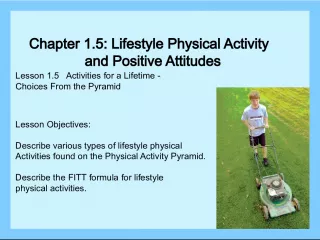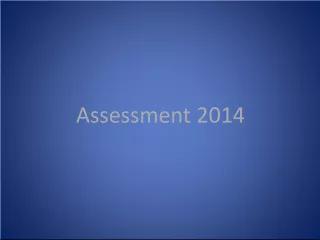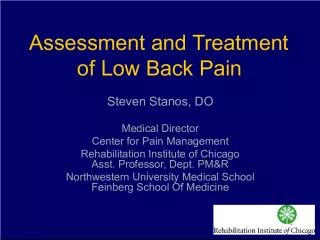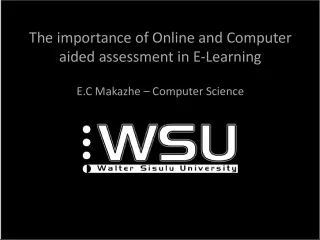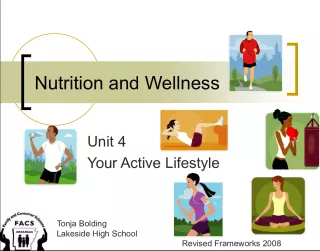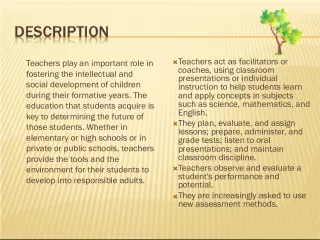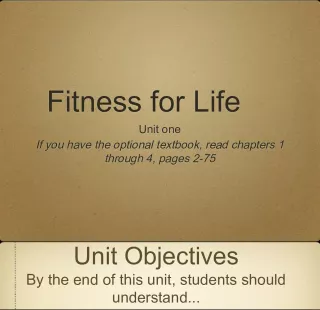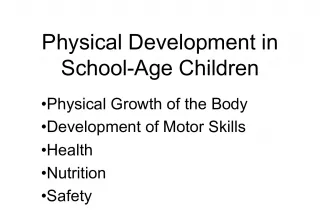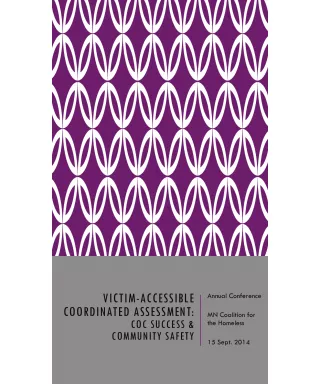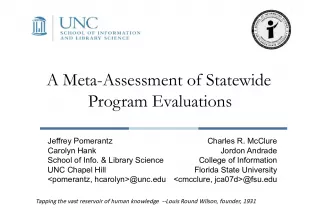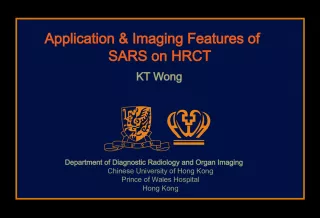The Role of Physical Assessment in Nursing
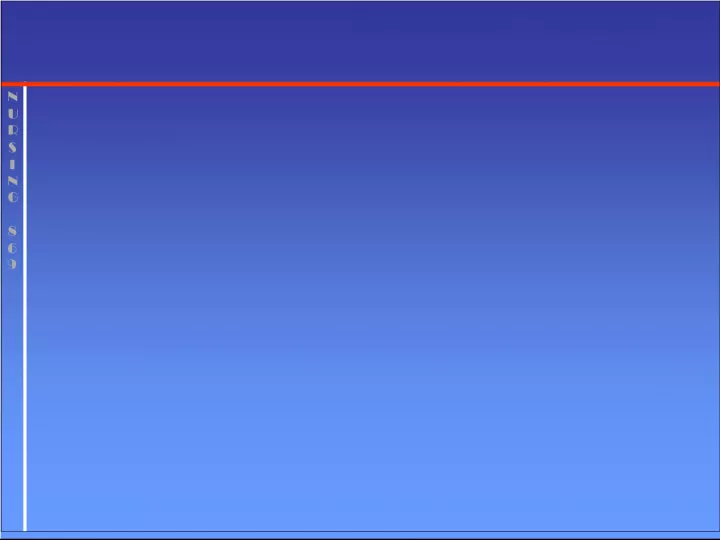

This article discusses the importance of physical assessment in nursing, including gathering baseline data, supplementing and confirming data in the nursing history, identifying nursing diagnoses, making clinical judgments about changing patient status, and evaluating outcomes of care. It also covers subjective and objective data collection and interpretation.
- Uploaded on | 0 Views
-
 jaylynn
jaylynn
About The Role of Physical Assessment in Nursing
PowerPoint presentation about 'The Role of Physical Assessment in Nursing'. This presentation describes the topic on This article discusses the importance of physical assessment in nursing, including gathering baseline data, supplementing and confirming data in the nursing history, identifying nursing diagnoses, making clinical judgments about changing patient status, and evaluating outcomes of care. It also covers subjective and objective data collection and interpretation.. The key topics included in this slideshow are nursing, physical assessment, baseline data, nursing diagnosis, clinical judgment, outcomes of care, subjective data, objective data,. Download this presentation absolutely free.
Presentation Transcript
1. N U R S I N G 8 6 9 Physical Assessment Physical Assessment
2. N U R S I N G 8 6 9 Gather baseline data Supplement, confirm, or refute data in nursing hx Confirm and identify nursing diagnosis Make clinical judgments about changing status Evaluate the physiological outcomes of care Purpose Purpose
3. N U R S I N G 8 6 9 Subjective Objective Data Data
4. N U R S I N G 8 6 9 What client or family tells you Symptoms Im in pain I feel anxious There is a stabbing pain in my chest Subjective Data Subjective Data
5. N U R S I N G 8 6 9 Information gained through the nurses senses Signs or observations B/P 120/70 Lung sounds clear in all lobes bilaterally Pt grimaces with pain and guards abdomen Abdomen soft, tender, nondistended Objective Data Objective Data
6. N U R S I N G 8 6 9 Provides baseline subjective information Family history Life patterns Sociocultural history Spiritual health Mental reactions Emotional reactions Health History Health History
7. N U R S I N G 8 6 9 Inspection Palpation Percussion Auscultation Olfaction Skills Skills
8. N U R S I N G 8 6 9 Process of observation Good lighting Position and expose body parts for optimal viewing Inspect for size, shape, color, symmetry, & position Inspection Inspection
9. N U R S I N G 8 6 9 Patient should be relaxed and positioned comfortably Tender areas palpated last Warm hands, gentle touch, short fingernails Apply pressure slowly, gently, and deliberately Light palpation precedes deep palpation Assess softness/rigidity, masses, temperature, size Vital arteries NOT palpated in manner that obstructs flow Palpation Palpation
10. N U R S I N G 8 6 9 Tapping to evaluate size, borders, and consistency of body organs and discover fluid in body cavities Helps verify abnormalities reported from x-ray Character of sound depends on density of underlying tissue Abnormal sounds suggest mass, air, or fluid in organ or body cavity Direct method Indirect method Percussion Percussion
11. N U R S I N G 8 6 9 Sounds produced by body Quiet environment Good stethoscope Stethoscope placed next to skin Diaphragm used for high-pitched sounds Bell used for low pitched sounds Ausculation Ausculation
12. N U R S I N G 8 6 9 1. Frequency/pitch: # vibrations per second 2. Loudness: soft, medium, loud 3. Quality: types: gurgling, blowing 4. Duration: short, medium, long Listen. Listen.
13. N U R S I N G 8 6 9 Be familiar with nature and source of body odors Foul odors can help detect infections Olfaction Olfaction
14. N U R S I N G 8 6 9 Head-to-toe assessment Major body systems assessment Sytematic Approach Sytematic Approach
15. N U R S I N G 8 6 9 Begins at head and progresses down to the toes Most comprehensive Used to obtain baseline information to identify changes in patient status Head-to-toe Head-to-toe
16. N U R S I N G 8 6 9 Focuses on one system at a time Cardiac: heart sounds, pulses, capillary refill, B/P Respiratory: breath sounds, rate and depth, skin color Major body systems Major body systems
17. N U R S I N G 8 6 9 Stethoscope Stethoscope
18. N U R S I N G 8 6 9 Neuro status Mucous membranes and skin Cardiac assessment Respiratory assessment Abdominal assessment Upper and lower extremities Accessories such as IV line, catheters, & dressings Head-to-toe Head-to-toe
19. N U R S I N G 8 6 9 Assess during initial contact with client Look for signs of distress Body type Posture Hygiene Dress Mood Speech Signs of abuse General Appearance General Appearance
20. N U R S I N G 8 6 9 Assessed by talking with client How difficult is it to get the client to respond? Alert and oriented x 3 Oriented to person, place, and time Consciousness Level Consciousness Level
21. N U R S I N G 8 6 9 Shine light through pupil onto retina Cranial nerve III stimulated Observe for pupillary constriction Observe for accomodation Pupils: black, round, regular, equal in size, 3-7 mm Pupillary Response Pupillary Response
22. N U R S I N G 8 6 9 Cloudy pupil: cataracts Dilated pupil: glaucoma, trauma, neurologic disorder Constricted pupil: drug use Pinpoint pupil: opioid intoxication Pupils Pupils
23. N U R S I N G 8 6 9 Pupils equal, round, reactive to light, accommodation PERRLA PERRLA
24. N U R S I N G 8 6 9 Inside lower lip Inside cheek Nares Conjunctiva Look at : color, hydration, texture, lesions Normal : red, smooth, moist, without lesions Mucous Membranes Mucous Membranes
25. N U R S I N G 8 6 9 Apply firm pressure with pads of index and middle finger on pulse site without occluding pulse Measure strength of pulse and equality Assess carotid, radial, and pedal Also assess brachial, posterior tibial, and dorsalis pedis Peripheral Pulses Peripheral Pulses
26. PERIPHERAL PULSES
27. PERIPHERAL PULSES
28. N U R S I N G 8 6 9 0 Absent, not palpable 1+- Diminished, barely palpable 2+- Easily palpable, normal pulse 3+ - Full pulse, increased 4+ - Strong, bounding, cannot be obliterated Grading Grading
29. N U R S I N G N 8 6 9 Should test fingers and toes Press down on nail to compress capillaries Color goes white, then release Color should return briskly; < 3 seconds Document sluggish if > 3 seconds Capillary refill Capillary refill
30. N U R S I N G 8 6 9 Review: heart is in the center of the chest, behind and to left of the sternum Base is at top, apex is the bottom tip Apex touches anterior chest wall at 5 th intercostal space medial to left midclavicular line Heart pumps blood through 4 chambers Events on left side occurs just before those on right Valves open and close, pressures within rise and fall and chambers contract as blood flows though each chamber Heart Heart
31. HEART
32. N U R S I N G 8 6 9 Systole: ventricles contract and eject blood from left ventricle into aorta and from right ventricle into pulmonary system Diastole: ventricles relax and atria contract to move blood into ventricles and fill coronary arteries Cardiac Cycle Cardiac Cycle
33. N U R S I N G 8 6 9 S1: Lub: mitral valve closure S2: Dub: Aortic valve closure APE to Man: Aortic, pulmonic, Erbs Point, Tricuspid, Mitral Heart Sounds Heart Sounds
34. HEART
35. N U R S I N G N U R 8 6 9 Apex and bases opposite from heart: apex at top, bases at bottom Right lung has 3 lobes, left has two Angle of Louis where 2 nd rib articulates with sternum 2 nd intercostal space is below 2 nd rib and is starting point on right Use diaphragm of stethoscope Inspiration and expiration = one breath Listen to both in each area Go from apex to bases comparing side to side Lung Sounds Lung Sounds
36. LUNGS
37. N U R S I N G 8 6 9 Measure respiratory rate without clients awareness After checking radial pulse, keep hand at pulse site and begin counting respirations Observe depth of respirations Documentation for normal: lungs sounds clear and equal in all lobes bilaterally Respiratory Rate Respiratory Rate
38. N U R S I N G 8 6 9 Color Turgor Assess for breakdown Skin Skin
39. N U R S I N G 8 6 9 Sounds, masses, tenderness Divide into four quadrants: RUQ, RLQ, LUQ, LLQ Inspect then auscultate Bowel sounds: absent, hypoactive, hyperactive Listen continuously for 5 minutes to determine absence Palpate and/or percuss after listening Abdomen should be soft, non-tender, non-distended Abdomen Abdomen
40. ABDOMEN
41. ABDOMEN
42. N U R S I N G 8 6 9 Pedal pulses Foot strength bilaterally Homans Sign Capillary refill Edema Pain Lower Extremities Lower Extremities
43. EDEMA
44. N U R S I N G 8 6 9 Temperature Pulse Respirations Blood Pressure Vital Signs Vital Signs
45. N U R S I N G 8 6 9 Oral Rectal (one degree higher than oral) Axillary (one degree lower than oral) Tympanic Esophageal Pulmonary artery Urinary bladder Nursing 110 Midway College Temperature Sites Temperature Sites
46. N U R S I N G 8 6 9 Age Exercise Hormone level Circadian rhythm Stress Environment Temperature alteration Factors Factors
47. N U R S I N G 8 6 9 Lateral force on walls of artery by pulsing blood under pressure from heart Maximum pressure with ejection is systolic Minimum pressure with ventricular relaxation is diastolic Measured in mm Hg Normal Adult: 110-140/60-90 Blood Pressure Blood Pressure
48. N U R S I N G 8 6 9 Age B/P increases with age Stress Race increased in African-Americans Medications Diurnal Variation Gender Factors affecting B/P Factors affecting B/P
49. N U R S I N G 8 6 9 Decrease in blood pressure when changing from lateral to upright position Can be caused by dehydration, anemia, prolonged bedrest, vasodilation from B/P medications Record B/P and pulse with client lying, sitting, and standing. Obtain readings 1-3 minutes after position change. Orthostatic Hypotension Orthostatic Hypotension

